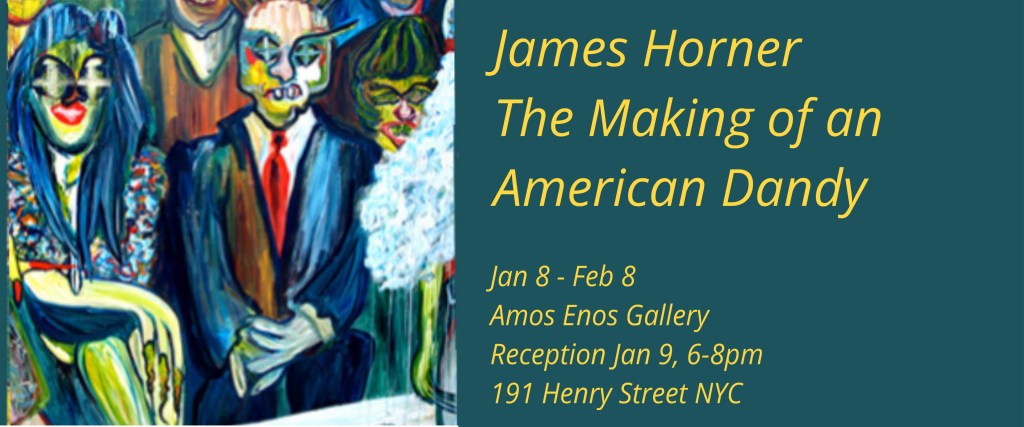
Contributed by Jonathan Stevenson / As the title “Blue Italian Skies Above” suggests, walking into the exhibition of Edith Schloss’s paintings now at Alexandre Gallery produces a kind of pastoral contentment. Many of the paintings depict a swatch of Italian beach to which she decamped from Rome – her primary home from 1962, when she left New York, until her death in 2011. A tranquil blue seems dominant in her palette, and the phenomena she presents in her calculatedly primitive pastiches – flowers, butterflies, tablecloths, tchotchkes, the sun, the moon, occasionally what looks phallic – can all be associated with good vibes of one kind or another. Don’t be fooled into thinking she was a shallow, acquiescent Pollyanna, though. Lurking in that casual lightness is a distinct quality of mortality and limitation.

The sense of that quality is not tragic but rather stoic – maybe wistful but resolutely short of sentimental. As she reveals in her posthumously published memoir The Loft Generation, she was far from clueless. She decried the diminution of women in the “what the fuck man’s land” of the New York art scene in the 1950s, and later the difficulty of being taken seriously as an artist while earning a living as an art writer and critic. When her work comes under closer scrutiny, the blue cheer of the 20 paintings yields to mood shifts, conveyed by changing seasons, weather, or time of day, rendered with elegant simplicity, and echoed in Schloss’s titles.

While Open Window (June 4) projects venturing forth from the household, Winter Sun imparts a confining insularity in view of what’s outside: the promise and the limits of circumstance. Two other pairings – Summer and Rustic; Spring Moon and Peace (September 6) – operate to similar effect. On a more compressed chronology, compare the generous blue strip of sky with the gently presiding yellow sun in Melograno and the parsimonious bit of sky with the decisively setting red sun in Melograno Dusk. Likewise, Sundown and the less populated Going West chronicle denouement and then departure. The net psychological effect of these two tandems is: one more day gone, a fact of life and something to consider.


Schloss’s paintings might at first seem resonant of James Salter’s haunting 1975 novel Light Years, a signature story of insidious boomer despair in which the privileged protagonist is ground down and dissipated by the time he is in his early 50s and left to endure a hollow life. Salter titled his doleful memoir, published 22 years later, Burning the Days. As Jason Andrew notes in his accompanying essay, “Edith Schloss: Crude Poetry,” if there is joie de vivre in her paintings, they also carry “something forlorn” that derives from “her sense of transitoriness – the brevity of the moment and the ephemeral nature of life.” Yet Schloss lived a long life – she died at 92 – and did not waste it. On balance, her outlook seems earthily upbeat: the paintings that planted her sensibility – Rignalia and Hot Cross Buns, both made in 1967– have no horizon, and, though the subsequent ones do expand outward, the foreground retains primacy. In Blue Italian Skies Above – the title painting – those skies pointedly occupy little of the picture plane.




Schloss, Andrew aptly concludes, was “an unsentimental romantic” who “reveled in the present and was brutally devoted to it.” Her approach to painting broadly resembled John Ford’s way of making movies. Both adopted a fixed vantage – no tracking or panning – in which a few tableaux could play out, with the eye trained on the horizon. For Ford, that area tended to be a Western plateau; he famously favored shooting in Monument Valley, on the Arizona–Utah border. For Schloss, it was an intimate segment of beach, water and sometimes sky seen from a window. Both valued a consistent mise-en-scène through which the world as it proceeded could be reliably observed, recorded, and remembered. Elizabeth Murray distilled the pleasures of everyday life alongside its hovering transience with freewheeling, unalloyed verve and panache. As this quietly moving exhibition demonstrates, Edith Schloss did it less brashly, but with comparable nuance and assuredness.
“Edith Schloss: Blue Italian Skies Above,” Alexandre Gallery, 291 Grand Street, LES, New York, NY. Through June 4, 2022.























Hi Jonathan,
Cool insight/coinage of new descriptive, “deep cheer” RE Edith Schloss’s works. I have seen them in her Rome studio and agree completely.
Cheers, Cate Whittemore (formerly of Cleveland Park school days)
http://Www.catewhittemore.com